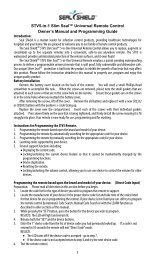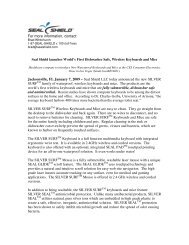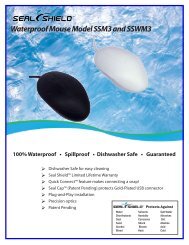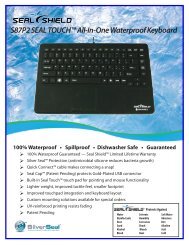Nanocrystalline silver dressings in wound management - Seal Shield
Nanocrystalline silver dressings in wound management - Seal Shield
Nanocrystalline silver dressings in wound management - Seal Shield
Create successful ePaper yourself
Turn your PDF publications into a flip-book with our unique Google optimized e-Paper software.
Fong and Wood<br />
In summary, there is a lack of animal studies on<br />
nanocrystall<strong>in</strong>e <strong>silver</strong>, but the available literature reviewed<br />
suggested that nanocrystall<strong>in</strong>e <strong>silver</strong> has a role <strong>in</strong> alter<strong>in</strong>g the<br />
<strong>in</strong>flammatory events <strong>in</strong> <strong>wound</strong>s and also facilitate the early<br />
phase of <strong>wound</strong> heal<strong>in</strong>g. There is evidence to suggest that<br />
Acticoat TM is an effective antimicrobial and is the dress<strong>in</strong>g of<br />
choice <strong>in</strong> several cases as it limits the frequency of dress<strong>in</strong>g<br />
changes. Acticoat TM may be suitable as a protection for<br />
contam<strong>in</strong>ation on cultured sk<strong>in</strong> substitutes used for <strong>wound</strong><br />
closure. Animals and humans differ <strong>in</strong> structure and function.<br />
Therefore extrapolations of f<strong>in</strong>d<strong>in</strong>gs from animal models to<br />
the human environment must be done with caution.<br />
Evidence from human studies <strong>in</strong>to<br />
nanocrystall<strong>in</strong>e <strong>silver</strong><br />
There is a lack of high quality designed research such as<br />
randomized control trials <strong>in</strong> human studies <strong>in</strong>to nanocrystall<strong>in</strong>e<br />
<strong>silver</strong> <strong>dress<strong>in</strong>gs</strong>. However a search of the literature revealed<br />
many human comparative studies, case series, and <strong>in</strong>dividual<br />
reports of the applications of nanocrystall<strong>in</strong>e <strong>silver</strong> <strong>in</strong> <strong>wound</strong><br />
<strong>management</strong>.<br />
In an earlier study <strong>in</strong> 1998 Tredget conducted a matched<br />
paired randomized study to evaluate the efficacy and safety<br />
of Acticoat TM for burn <strong>wound</strong> treatment. Thirty patients with<br />
symmetrical burns were randomly assigned to be dressed with<br />
Acticoat TM or <strong>silver</strong> nitrate solution <strong>dress<strong>in</strong>gs</strong>. They found that<br />
the Acticoat TM -treated patients had less pa<strong>in</strong> levels <strong>in</strong>itially<br />
but the pa<strong>in</strong> levels were comparable with that of the <strong>silver</strong><br />
nitrate group of patients after 2 hours. They also found that<br />
the frequency of dress<strong>in</strong>g changes and <strong>in</strong>cidence of <strong>wound</strong><br />
sepsis were less <strong>in</strong> the Acticoat TM -treated group (Tredget<br />
et al 1998).<br />
Voight presented case presentations of 6 patients with<br />
venous ulcers treated with Acticoat TM . They reported <strong>wound</strong><br />
heal<strong>in</strong>g <strong>in</strong> these patients, one patient with a 5 month old ulcer<br />
was healed with Acticoat TM <strong>in</strong> 194 days and another with a<br />
5-week-old ulcer which healed <strong>in</strong> 27 days. In another case<br />
series, Voight demonstrated the effects of Acticoat TM on 4<br />
patients with debicutus ulcers, one with a 24-month-old ulcer<br />
healed <strong>in</strong> 27 days and another 2-week-old ulcer healed <strong>in</strong><br />
14 days with Acticoat TM . They demonstrated a reduction <strong>in</strong><br />
exudate fluid volumes <strong>in</strong> all cases treated with Acticoat TM . The<br />
same authors conducted a multi-centered (41 centers) survey<br />
for the use of Acticoat TM dress<strong>in</strong>g. They reported that 61% of<br />
the centres surveyed used Acticoat TM and up to 52% of these<br />
used Acticoat TM as a cover for Integra, a dermal regeneration<br />
template for full thickness burns reconstruction. They also<br />
reported that 4.8% of those surveyed used Acticoat TM as their<br />
pr<strong>in</strong>cipal dress<strong>in</strong>g. They concluded that Acticoat TM is cost<br />
effective, improved <strong>wound</strong> heal<strong>in</strong>g and able to be applied to<br />
all types of <strong>wound</strong>s (Voight and Paul 2001).<br />
Innes <strong>in</strong> 2001 <strong>in</strong>vestigated the use of Acticoat TM and<br />
Allevyn foam on donor sites <strong>in</strong> a prospective controlled<br />
matched pair study on 15 patients with bilateral donor sites.<br />
They found that donors treated with Allevyn foam were<br />
more than 90% re-epitheliased at a mean 9.1 days, whereas<br />
the Acticoat TM -treated donor sites were more than 90%<br />
re-epitheliased at 14.5 days. They concluded Allevyn was<br />
significantly better than Acticoat TM for treat<strong>in</strong>g donor sites<br />
and the Acticoat TM -treated donor sites had worse scars at 2<br />
weeks than Allevyn-treated donors but showed no difference<br />
at 3 months (Innes et al 2001).<br />
The role of <strong>silver</strong> <strong>in</strong> <strong>wound</strong> heal<strong>in</strong>g was exam<strong>in</strong>ed <strong>in</strong><br />
a s<strong>in</strong>gle center, open-label, unbl<strong>in</strong>ded pilot study of 11<br />
extended-care facility outpatients or residents with chronic<br />
<strong>wound</strong>s of mixed etiology by Kirshner et al <strong>in</strong> 2002. All<br />
<strong>wound</strong>s had a history of at least 3 months and had no<br />
decrease <strong>in</strong> <strong>wound</strong> size <strong>in</strong> the 3 weeks preced<strong>in</strong>g the study.<br />
The patients were all treated with Acticoat TM and had their<br />
<strong>dress<strong>in</strong>gs</strong> changed daily <strong>in</strong> the first week and on alternate<br />
days therafter. All used <strong>dress<strong>in</strong>gs</strong> were reserved for analyses<br />
and fluid collection. Eight patients completed the study, the<br />
authors found a decrease <strong>in</strong> matrix metalloprote<strong>in</strong>ase activity<br />
<strong>in</strong> the first 2 days of treatment. This suggested that once<br />
matrix metalloprote<strong>in</strong>ase activity is altered it can rema<strong>in</strong> so<br />
with the cont<strong>in</strong>ued use of the nanocrystall<strong>in</strong>e <strong>silver</strong> dress<strong>in</strong>g<br />
(Kirshner 2002).<br />
Deml<strong>in</strong>g and DeSanti <strong>in</strong> 2002 exam<strong>in</strong>ed the effects of<br />
Acticoat TM and Xeroform TM as <strong>dress<strong>in</strong>gs</strong> over meshed sk<strong>in</strong><br />
grafts. Twenty patients, each hav<strong>in</strong>g 2 areas of meshed sk<strong>in</strong><br />
grafts were treated with Acticoat TM <strong>in</strong> one and Xeroform TM<br />
with 0.01% neomyc<strong>in</strong> and polymyx<strong>in</strong> on the other <strong>wound</strong>.<br />
Wounds were evaluated every 3 days and <strong>wound</strong> swabs<br />
obta<strong>in</strong>ed. They found that Acticoat TM greatly <strong>in</strong>creased the<br />
rate of <strong>wound</strong> closure than the standard Xeroform TM <strong>dress<strong>in</strong>gs</strong><br />
(Deml<strong>in</strong>g and DeSanti 2002).<br />
Dunn <strong>in</strong> 2004 presented reports from the 2003 European<br />
Burns Association meet<strong>in</strong>g of success with the use of<br />
Acticoat TM on burn patients by several cl<strong>in</strong>icians across<br />
Europe. Acticoat TM <strong>dress<strong>in</strong>gs</strong> were applied to children with<br />
partial to full thickness burns. Besides the antimicrobial<br />
effects Acticoat TM -treated <strong>wound</strong>s generally improved and<br />
healed naturally or <strong>in</strong> conjunction with surgical <strong>in</strong>terventions.<br />
There were reports of improved pa<strong>in</strong> levels, reduction <strong>in</strong> the<br />
446<br />
International Journal of Nanomedic<strong>in</strong>e 2006:1(4)







